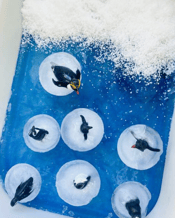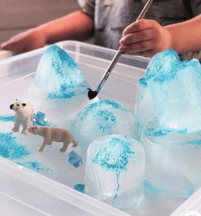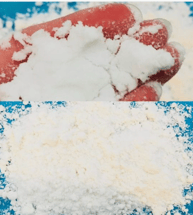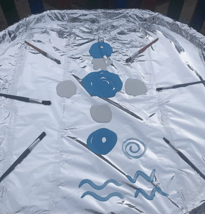Books for little readers teaching about Polar Regions
Reading is one of the best ways to teach language acquisition and learn diversity of the sounds and words. Books help us to provide vocabulary rich environments to the children in our care and it is one of the fundamental teaching techniques in early development! Selection of the books bellow will provide you with a wonderful opportunities to learn about Polar Regions, explore new animals and words!
The Emperor penguin is the only large animal to remain on the Antarctic mainland throughout its bitterly inhospitable winter. Once the female has laid her egg, she heads back to the sea, leaving the male to incubate it. He then spends two months standing on the freezing cold ice with the egg on his feet! This is his story.
Everybody knows that penguins belong at the South Pole and polar bears live at the North Pole - but what would happen if, one day, a family of picnicking penguins accidentally got lost? When the hapless Pilchard-Brown family find themselves at completely the wrong pole, they need Mr White, the friendly polar bear, to guide them all the way home. . .
Why Sensory Play?
Sensory play is crucial for the development of babies and young children as it stimulates their senses and encourages exploration. Warm and cold is great sensory experience and representation of Arctic and Antarctic in a child friendly way! Regular exposure to a variety of sensory experiences supports the development of sensory processing skills. This is crucial for organising and interpreting sensory information, laying the foundation for more complex cognitive functions.
Incorporating sensory play into a baby's routine provides a holistic approach to early childhood development, addressing physical, cognitive, social, and emotional aspects of growth. Here are some benefits of sensory play for babies.
Cognitive Development - Sensory play helps in the development of cognitive skills by allowing babies to explore different textures, shapes, and sizes. It enhances their understanding of the world around them and promotes problem-solving skills.
Fine Motor Skills - Engaging in sensory activities, such as grasping and manipulating objects of various textures, helps babies develop fine motor skills. These activities encourage the use and coordination of small muscles, fostering better control over their hands and fingers.
Language Development - Sensory experiences often involve language-rich interactions. Describing the sensations, naming objects, and talking about the play activities with caregivers or peers contribute to language development in babies.
Social Skills - Sensory play can be a social experience when babies engage in it with parents, siblings, or other caregivers. Sharing sensory materials, taking turns, and participating in group activities contribute to the development of social skills.
Sensory Integration - Sensory play helps babies integrate information from their senses, such as touch, sight, smell, taste, and hearing. This integration is essential for overall sensory processing and can have positive effects on a child's ability to focus, self-regulate, and interact with the environment.
Emotional Regulation - Exploring different textures and sensations can have a calming effect on babies. Sensory play provides opportunities for self-soothing and emotional regulation as babies learn to cope with different stimuli and experiences.
Creativity and Imagination - Sensory activities often encourage creativity and imaginative play. Babies can explore open-ended materials, allowing them to use their imagination to create and discover new ways of interacting with the world.
Body Awareness - Engaging in sensory play helps babies develop a sense of their own bodies. Whether it's crawling through tunnels, feeling different textures, or exploring their surroundings, babies become more aware of their bodies and how they move.
Carer-Child Bonding - Sensory play provides opportunities for bonding between parents and babies. When caregivers actively participate in sensory activities, it strengthens the parent-child relationship through shared experiences and positive interactions.
Icy sensory Experiences
For this amazing and Icy sensory play use ice cubes or simply freeze some water in different moulds! Adding hidden arctic animals will enhance children's curiosity and engage them into extended play.
Use a wide tray safely placed on a flat surface, add your frozen shapes, some arctic toys and here you just made a small world of Winter Animals!
If you want to further enhance your little ones sensory experience make some 'food safe' snow! For this wonderful sensory you will need 2 cups of cornflour, one cup of plain flour, half a cup of sunflower oil (any other oil that does not have a colour to it will also do). Mix everything together in a mixing bowl then, rub the mixture in between your hands as if you are making the crumbles. Voila! You just made a snow for sensory play! Now you can build a little snowman.
Foil reflection creates an imitation of ice and arctic regions through play. For safer experience use medical foil blanket. It will not chip and tear and provide a safe play for your baby!
Sensory Play Activities for Preschoolers: Polar-Themed Fun
1. Frozen Arctic Animal Rescue
- What You Need: Small Arctic animal figurines, ice molds, warm water in squeeze bottles, and a flat tray.
- How to Play: Freeze the Arctic figurines in water-filled molds. Once frozen, place them in a tray and encourage children to ‘rescue’ the animals using warm water from squeeze bottles.
- Why It’s Great: This activity promotes problem-solving skills, hand-eye coordination, and an understanding of how temperature affects ice.
2. Build a Winter Wonderland
- What You Need: Homemade ‘food-safe snow’ (2 cups cornflour, 1 cup plain flour, ½ cup sunflower oil) and Arctic toys like polar bears and penguins.
- How to Play: Children can mold the snow into various shapes, such as igloos or snowmen, while incorporating their Arctic figurines.
- Why It’s Great: This encourages creative thinking, fine motor skill development, and an appreciation of Arctic wildlife.
3. Reflective Ice Play with Foil Blankets
- What You Need: Medical foil blankets, icy molds, and Arctic toys.
- How to Play: Lay the foil blanket on a flat surface and arrange the icy molds on top. Children can explore the reflective surface and pretend it’s an Arctic ice sheet.
- Why It’s Great: This activity engages visual and tactile senses, simulating the icy glimmer of the Polar Regions safely.
4. Northern Lights Painting
- What You Need: Dark construction paper, paintbrushes, and colors like green, purple, and blue.
- How to Play: Encourage children to paint swirling patterns inspired by the Aurora Borealis. Show pictures of the Northern Lights to inspire their artwork.
- Why It’s Great: This combines sensory exploration with artistic expression, introducing children to the natural beauty of the Polar Regions.
5. Arctic Animal Tracks in Snow
- What You Need: A shallow tray filled with homemade ‘food-safe snow’ and small Arctic animal toys.
- How to Play: Children press the toys into the snow to create footprints, then guess which animal made each track.
- Why It’s Great: This introduces children to biodiversity and encourages imaginative storytelling about life in the Arctic.
These sensory activities engage preschoolers through hands-on, interactive play, fostering creativity, curiosity, and an understanding of the Polar Regions.
For more ideas on engaging your little ones during the colder months, explore our comprehensive guide on winter activities for preschoolers. This resource offers a variety of fun and educational activities to keep your preschoolers entertained throughout the winter season.
FAQs on Exploring Arctic and Antarctic Through Sensory Play
Why is sensory play important for babies and young children?
Sensory play is crucial because it stimulates a child’s senses and promotes exploration. Activities like icy sensory experiences, where children can interact with textures, temperatures, and shapes, enhance their ability to process sensory information. It fosters cognitive development, fine motor skills, and even language acquisition as children explore and interact with their environment. Sensory play also helps children develop social skills, emotional regulation, and creativity while providing opportunities for bonding with caregivers.
How does sensory play support cognitive development in young children?
Through sensory play, children explore different textures, shapes, and materials, helping them understand their surroundings better. For example, activities like making ‘food-safe snow’ or building a small winter-themed world encourage problem-solving and critical thinking. Sensory activities build connections in the brain that support later complex learning, helping children think logically and imaginatively.
What are some specific sensory activities to teach about the Polar Regions?
Activities like using frozen water in various molds, adding Arctic animal figurines, and creating small-world setups with icy elements are fantastic for engaging children. Foil reflections, made with medical foil blankets, simulate icy environments and encourage tactile exploration. Making ‘food-safe snow’ allows children to mold and shape, adding a hands-on dimension to learning about the Arctic and Antarctic. Can sensory play help with emotional development?
Yes, sensory play can significantly aid emotional regulation. Engaging with calming textures, such as smooth ice or soft, crumbly ‘food-safe snow,’ helps children soothe themselves. These activities teach children how to manage new stimuli in a safe and controlled environment, fostering their ability to self-regulate and manage emotions. How can sensory play enhance social skills in a group setting?
Sensory play encourages interaction when children work together to explore materials, share tools, and build imaginative worlds. Group activities like creating igloos from frozen blocks or discussing Arctic animals during play stimulate communication and collaboration. Such shared experiences help children learn turn-taking, cooperation, and effective communication while building friendships.
Subscribe here!

30-Dec-2023 19:10:33
Related Articles














Write a Comment